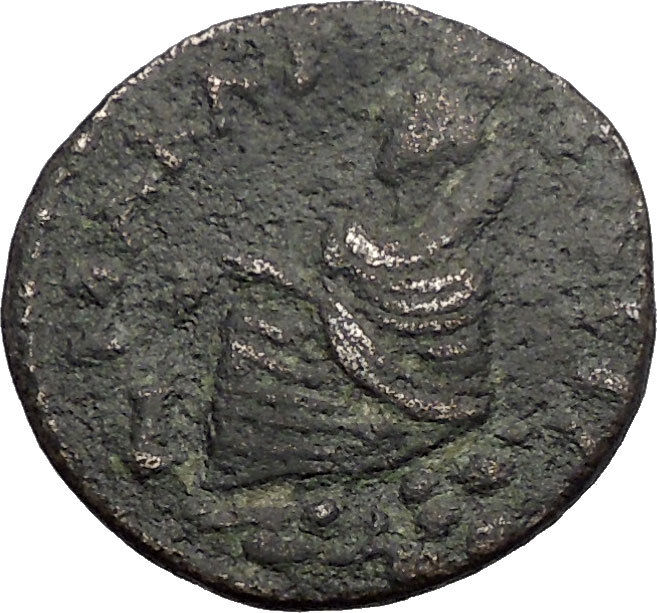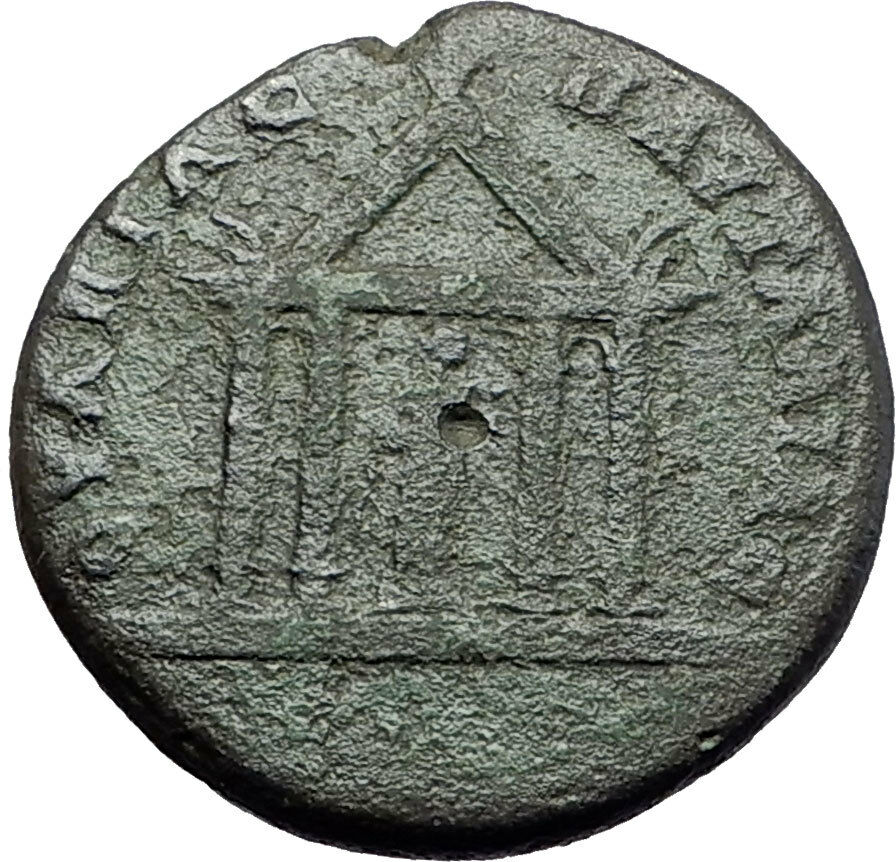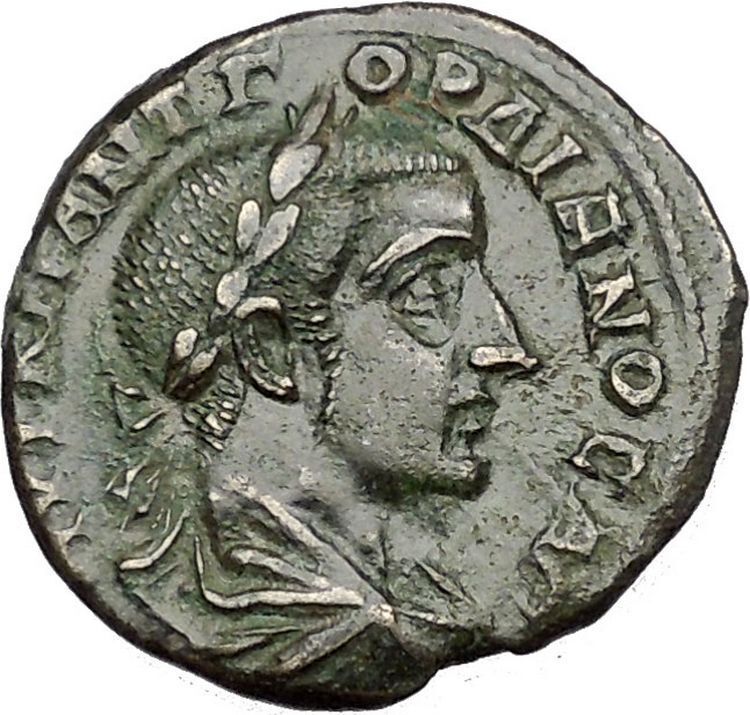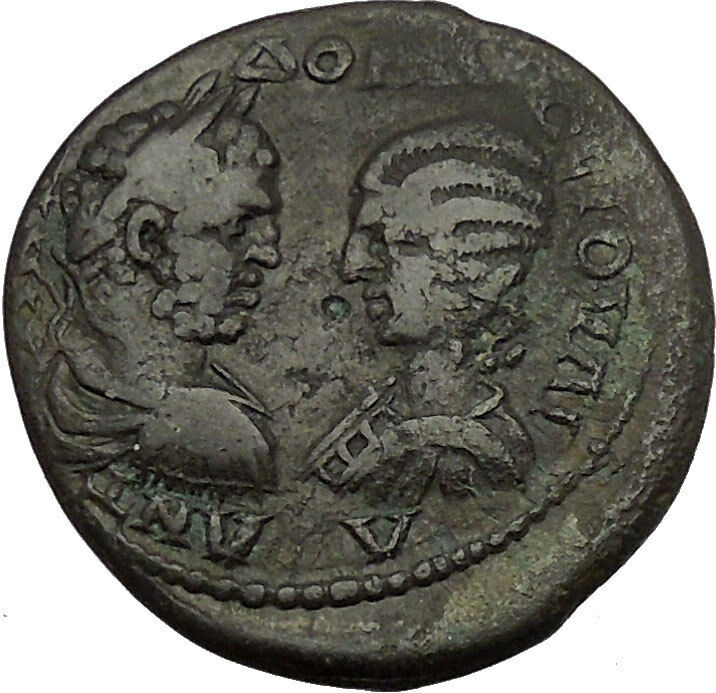|
Greek city of Mopsos in Cilicia
Pseudo-autonomous Issue. Time of Claudius (41-54 A.D.)
Bronze 14mm Dated year 119, struck 51/52 A.D.
Reference: RPC I 4057.
Certification: NGC Ancients Ch VF 6156464-085
ΘΙΡ, Laureate head of Apollo right.
ΜΟΨΕΑΤΩΝ ΤΗΣ ΙΕΡΑΣ / KAI / AYTONOMOY, Artemis standing facing, head right, holding bow and drawing arrow.
Mopsos was situated on the river Pyramos, north-east of Mallos, the city was name after the brother of Amphilochos. During the reign of Antiochos IV of the Seleukid empire, it bore the name of Seleukeia.
You are bidding on the exact item pictured, provided with a Certificate of Authenticity and Lifetime Guarantee of Authenticity.
 In Greek and Roman mythology, Apollo, is one of the most important and diverse of the Olympian deities. The ideal of the kouros (a beardless youth), Apollo has been variously recognized as a god of light and the sun; truth and prophecy; archery; medicine and healing; music, poetry, and the arts; and more. Apollo is the son of Zeus and Leto, and has a twin sister, the chaste huntress Artemis. Apollo is known in Greek-influenced Etruscan mythology as Apulu. Apollo was worshiped in both ancient Greek and Roman religion, as well as in the modern Greco-Roman Neopaganism. In Greek and Roman mythology, Apollo, is one of the most important and diverse of the Olympian deities. The ideal of the kouros (a beardless youth), Apollo has been variously recognized as a god of light and the sun; truth and prophecy; archery; medicine and healing; music, poetry, and the arts; and more. Apollo is the son of Zeus and Leto, and has a twin sister, the chaste huntress Artemis. Apollo is known in Greek-influenced Etruscan mythology as Apulu. Apollo was worshiped in both ancient Greek and Roman religion, as well as in the modern Greco-Roman Neopaganism.
As the patron of Delphi (Pythian Apollo), Apollo was an oracular god – the prophetic deity of the Delphic Oracle. Medicine and healing were associated with Apollo, whether through the god himself or mediated through his son Asclepius, yet Apollo was also seen as a god who could bring ill-health and deadly plague as well as one who had the ability to cure. Amongst the god’s custodial charges, Apollo became associated with dominion over colonists, and as the patron defender of herds and flocks. As the leader of the Muses (Apollon Musagetes) and director of their choir, Apollo functioned as the patron god of music and poetry. Hermes created the lyre for him, and the instrument became a common attribute of Apollo. Hymns sung to Apollo were called paeans.
In Hellenistic times, especially during the third century BCE, as Apollo Helios he became identified among Greeks with Helios, god of the sun, and his sister Artemis similarly equated with Selene, goddess of the moon. In Latin texts, on the other hand, Joseph Fontenrose declared himself unable to find any conflation of Apollo with Sol among the Augustan poets of the first century, not even in the conjurations of Aeneas and Latinus in Aeneid XII (161-215). Apollo and Helios/Sol remained separate beings in literary and mythological texts until the third century CE.
 Artemis was one of the most widely venerated of the Ancient Greek deities. Some scholars believe that the name, and indeed the goddess herself, was originally pre-Greek. Homer refers to her as Artemis Agrotera, Potnia Theron “Artemis of the wildland, Mistress of Animals”. In the classical period of Greek mythology, Artemis (Greek: (nominative) Ἄρτεμις, (genitive) Ἀρτέμιδος) was often described as the daughter of Zeus and Leto, and the twin sister of Apollo. She was the Hellenic goddess of the hunt, wild animals, wilderness, childbirth, virginity and young girls, bringing and relieving disease in women; she often was depicted as a huntress carrying a bow and arrows. The deer and the cypress were sacred to her. In later Hellenistic times, she even assumed the ancient role of Eileithyia in aiding childbirth. Artemis was one of the most widely venerated of the Ancient Greek deities. Some scholars believe that the name, and indeed the goddess herself, was originally pre-Greek. Homer refers to her as Artemis Agrotera, Potnia Theron “Artemis of the wildland, Mistress of Animals”. In the classical period of Greek mythology, Artemis (Greek: (nominative) Ἄρτεμις, (genitive) Ἀρτέμιδος) was often described as the daughter of Zeus and Leto, and the twin sister of Apollo. She was the Hellenic goddess of the hunt, wild animals, wilderness, childbirth, virginity and young girls, bringing and relieving disease in women; she often was depicted as a huntress carrying a bow and arrows. The deer and the cypress were sacred to her. In later Hellenistic times, she even assumed the ancient role of Eileithyia in aiding childbirth.
Artemis later became identified with Selene, a Titaness who was a Greek moon goddess, sometimes depicted with a crescent moon above her head. She was also identified with the Roman goddess Diana, with the Etruscan goddess Artume, and with the Greek or Carian goddess Hecate.
 Mopsuestia (Greek: Μοψουεστία Mopsou(h)estia; Byzantine: Mamista, Manistra; Arabic: al-Maṣṣīṣah; Armenian: Msis, Mises, Mam(u)estia; Frankish: Mamistra) is an ancient city in Cilicia Campestris on the Pyramus River (now Ceyhan River) located approximately 20 km (12 mi) east of ancient Antiochia in Cilicia (present-day Adana, southern Turkey). From the city’s harbour the river is navigable to the Mediterranean Sea, a distance of over 40 km (24 mi). Mopsuestia (Greek: Μοψουεστία Mopsou(h)estia; Byzantine: Mamista, Manistra; Arabic: al-Maṣṣīṣah; Armenian: Msis, Mises, Mam(u)estia; Frankish: Mamistra) is an ancient city in Cilicia Campestris on the Pyramus River (now Ceyhan River) located approximately 20 km (12 mi) east of ancient Antiochia in Cilicia (present-day Adana, southern Turkey). From the city’s harbour the river is navigable to the Mediterranean Sea, a distance of over 40 km (24 mi).
The founding of this city is attributed in legend to the soothsayer Mopsus, who lived before the Trojan war, although it is scarcely mentioned before the Christian era. Pliny the Elder calls it the free city of Mopsos (Hist. nat., V, 22), but the ordinary name is Mopsuestia, as found in Stephanus of Byzantium and all the Christian geographers and chroniclers. Under the Seleucid Empire, the city took the name of Seleucia on the Pyramus (classical Greek: Σελεύκεια πρὸς τὸν Πύραμον, Seleukeia pros ton Pyramon; Latin: Seleucia ad Pyramum), but gave it up at the time of the Roman conquest; under Hadrian it was called Hadriana, under Decius Decia, etc., as we know from the inscriptions and the coins of the city. Constantius II built there a magnificent bridge over the Pyramus (Malalas, Chronographia, XIII; P.G., XCVII, 488) afterwards restored by Justinian (Procopius, De Edificiis, V. 5) and has been restored again recently.
Christianity seems to have been introduced very early into Mopsuestia and during the 3rd century there is mention of a bishop, Theodorus, the adversary of Paul of Samosata. Other famous residents of the early Christian period in the city’s history include Saint Auxentius (d. 360), and Theodore, bishop from 392�”428, the teacher of Nestorius. The bishopric is included in the Catholic Church’s list of titular sees. Along with much of Cilicia, the region was wrested from Roman control by the Arabs in the late 630s.
In 684 the Emperor Constantine IV recaptured Misis from its small Arab garrison and it remained an imperial possession until 703 (Theophanes, “Chronogr.”, A. M. 6178, 6193), when it was recaptured by ̔the Arabs, who rebuilt the fortifications, constructed a mosque, and maintained a permanent garrison. Because of its position on the frontier, the city was repeatedly fought over and was recaptured from time to time by the Byzantines: it was besieged in vain by the Byzantine troops of John I Tzimisces in 964, but was taken the following year after a long and difficult siege by Nicephorus Phocas.
Mopsuestia then numbered 200,000 inhabitants, some of whom were Muslim, and the Byzantines made efforts to re-Christianize the city. In the early 1090s Turkish forces overran the town, but were expelled in 1097 by Crusader troops under Tancred who took possession of the city and its strategic port, which were annexed to the Principality of Antioch. It suffered much from internecine war between Crusaders, Armenians, and Greeks who lost it and recaptured it, notably in 1106, 1132, and 1137. Finally in 1151-52 the Armenian Baron T’oros II captured the city and defeated the Greek counter attack led by Andronikos I Komnenos. Thereafter it remained a possession of the Armenian Kingdom of Cilicia, but was briefly captured and plundered by the Mamluks in 1266, 1275, and 1322. The Venetians and Genoese were licensed by the Armenians to maintain warehouses near the harbour to store goods brought from India. The Armenians were permanently evicted by the Mamluks in 1347. The city was the site of several church councils and possessed four Armenian churches; the Greek diocese still existed at the beginning of the fourteenth century (Le Quien, Oriens Christianus, II, 1002 ). In 1432 the Frenchman Bertrandon reported that he city was ruled by the Muslims and was largely destroyed. In 1515 Mopsuestia, and the whole of Cilica, was incorporated into the Ottoman Empire by Sultan Selim I. Since then it has steadily declined and became the small village of Misis. Misis was renamed Yakapınar in the 1960s. Only fragments of the medieval fortifications survive today. However, an etching of the circuit walls and towers was made in the mid-19th century. The Misis Mosaic Museum was founded in 1959 to exhibit the mosaics found in the area, including the famous “Samson Mosaic.”
In antiquity, Cilicia was the south coastal region of Asia Minor and existed as a political entity from Hittite times into the Armenian Kingdom of Cilicia during the late Byzantine Empire. Extending inland from the southeastern coast of modern Turkey, Cilicia is due north and northeast of the island of Cyprus and corresponds to the modern region of Çukurova in Turkey.

|









 In Greek and Roman mythology, Apollo, is one of the most important and diverse of the Olympian deities. The ideal of the kouros (a beardless youth), Apollo has been variously recognized as a god of light and the sun; truth and prophecy; archery; medicine and healing; music, poetry, and the arts; and more. Apollo is the son of Zeus and Leto, and has a twin sister, the chaste huntress Artemis. Apollo is known in Greek-influenced Etruscan mythology as Apulu. Apollo was worshiped in both ancient Greek and Roman religion, as well as in the modern Greco-Roman Neopaganism.
In Greek and Roman mythology, Apollo, is one of the most important and diverse of the Olympian deities. The ideal of the kouros (a beardless youth), Apollo has been variously recognized as a god of light and the sun; truth and prophecy; archery; medicine and healing; music, poetry, and the arts; and more. Apollo is the son of Zeus and Leto, and has a twin sister, the chaste huntress Artemis. Apollo is known in Greek-influenced Etruscan mythology as Apulu. Apollo was worshiped in both ancient Greek and Roman religion, as well as in the modern Greco-Roman Neopaganism. Artemis was one of the most widely venerated of the Ancient Greek deities. Some scholars believe that the name, and indeed the goddess herself, was originally pre-Greek. Homer refers to her as Artemis Agrotera, Potnia Theron “Artemis of the wildland, Mistress of Animals”. In the classical period of Greek mythology, Artemis (Greek: (nominative) Ἄρτεμις, (genitive) Ἀρτέμιδος) was often described as the daughter of Zeus and Leto, and the twin sister of Apollo. She was the Hellenic goddess of the hunt, wild animals, wilderness, childbirth, virginity and young girls, bringing and relieving disease in women; she often was depicted as a huntress carrying a bow and arrows. The deer and the cypress were sacred to her. In later Hellenistic times, she even assumed the ancient role of Eileithyia in aiding childbirth.
Artemis was one of the most widely venerated of the Ancient Greek deities. Some scholars believe that the name, and indeed the goddess herself, was originally pre-Greek. Homer refers to her as Artemis Agrotera, Potnia Theron “Artemis of the wildland, Mistress of Animals”. In the classical period of Greek mythology, Artemis (Greek: (nominative) Ἄρτεμις, (genitive) Ἀρτέμιδος) was often described as the daughter of Zeus and Leto, and the twin sister of Apollo. She was the Hellenic goddess of the hunt, wild animals, wilderness, childbirth, virginity and young girls, bringing and relieving disease in women; she often was depicted as a huntress carrying a bow and arrows. The deer and the cypress were sacred to her. In later Hellenistic times, she even assumed the ancient role of Eileithyia in aiding childbirth. Mopsuestia (Greek: Μοψουεστία Mopsou(h)estia; Byzantine: Mamista, Manistra; Arabic: al-Maṣṣīṣah; Armenian: Msis, Mises, Mam(u)estia; Frankish: Mamistra) is an ancient city in Cilicia Campestris on the Pyramus River (now Ceyhan River) located approximately 20 km (12 mi) east of ancient Antiochia in Cilicia (present-day Adana, southern Turkey). From the city’s harbour the river is navigable to the Mediterranean Sea, a distance of over 40 km (24 mi).
Mopsuestia (Greek: Μοψουεστία Mopsou(h)estia; Byzantine: Mamista, Manistra; Arabic: al-Maṣṣīṣah; Armenian: Msis, Mises, Mam(u)estia; Frankish: Mamistra) is an ancient city in Cilicia Campestris on the Pyramus River (now Ceyhan River) located approximately 20 km (12 mi) east of ancient Antiochia in Cilicia (present-day Adana, southern Turkey). From the city’s harbour the river is navigable to the Mediterranean Sea, a distance of over 40 km (24 mi).





